I did this as a three part post last year, the plan this year is to do it in one hit, but we shall see.
At the end of each season, at the beginning of September, it feels that it will be good to be orchid-free, as the previous five months always hare hectic with never enough time to get round to every site. And yet by the time Christmas comes round, we are longing for the hope of seeing the first flowering spike in as little as three months time.
As the new year progresses through January and February, each warm day is greeted with hope that the rosettes in the woods and on the downs will be getting bigger. Kent is a little behind Dorset when it comes for the first flowering orchid, doubly so when the Sawfly Orchid showed for a handful of years earlier this decade. The first Early Spiders were seen at the end of March on Dancing Ledge, but repeated visits to the woods in Kent to check on Early Purples and their growing spikes.
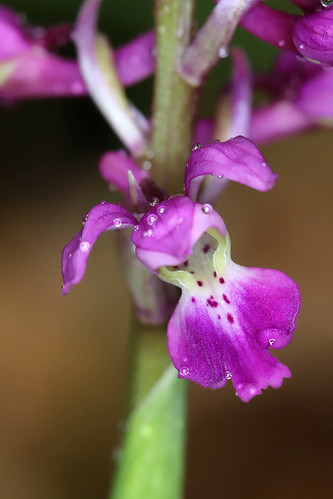 In the end, it was into April before I found my first flowering spike. It was a single flower on a single spike. It was April 7th.
In the end, it was into April before I found my first flowering spike. It was a single flower on a single spike. It was April 7th.The game was afoot.
For the Early Purples, it was a good year, for the most part, well, except Covet Wood where the once flourishing colony has been decimated, spikes coming up blind and the once fairly numerous var albas are now nowhere to be seen.
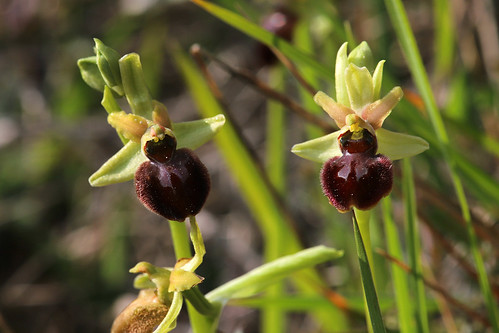 Five days later the Early Spiders began to show on Samphire Hoe. The days when the Hoe was home to 25,000 spikes seem to be a distant memory now. The warden told me that the influx of other species continues apace, crowding out the orchids, and it might be just a few years before the cliff tops are the only place near there where they will be found. As it always used to be.
Five days later the Early Spiders began to show on Samphire Hoe. The days when the Hoe was home to 25,000 spikes seem to be a distant memory now. The warden told me that the influx of other species continues apace, crowding out the orchids, and it might be just a few years before the cliff tops are the only place near there where they will be found. As it always used to be.I no longer go Green Wing hunting at Sandwich Bay, for the sole reason that that is not the only location where they are found, but it is because having to dodge angry golfers and their errant balls. Now there is a site in the Eleham Valley a short drive away, and then there is the glory that is Marden Meadow just an hour away. Marden is now expanding. The two main meadows are now glorious come the peak season at the beginning of may, even on April 21st there was a good show. A third meadow is now filling with orchids and Adder's Tongue Ferns.
 On the way back from Marden, we call in at Steps at the top of the A249, and there we found a single spike of a Lady Orchid starting to flower. It counts!
On the way back from Marden, we call in at Steps at the top of the A249, and there we found a single spike of a Lady Orchid starting to flower. It counts!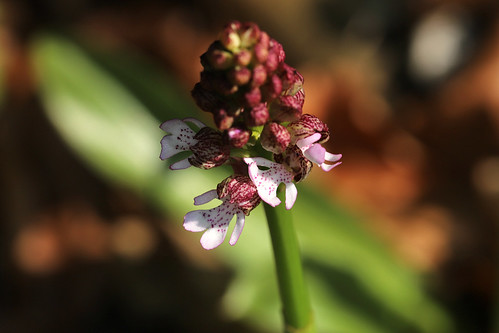 The next day, April 22nd, we saw our first Fly at Yocklett's. Always a bit of a hunt to find the first spike because of the single tiny flower showing, but in a beam of sunlight, the lip shows a glorious bright dark red. Again, Yockletts had a good year, not quite as good as 2018, but the spikes are spreading firther, and later in May, the Green Fly reappeared.
The next day, April 22nd, we saw our first Fly at Yocklett's. Always a bit of a hunt to find the first spike because of the single tiny flower showing, but in a beam of sunlight, the lip shows a glorious bright dark red. Again, Yockletts had a good year, not quite as good as 2018, but the spikes are spreading firther, and later in May, the Green Fly reappeared.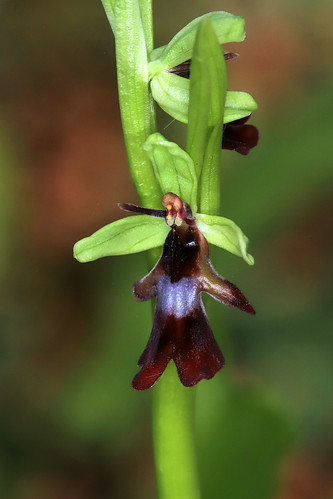 Steps is a wonderful early site, good for Early Purples as well as Lady too, before most other sites in the county. In fact Steps would have a bumper year for Lady, with well over a hundred spikes showing well in the cleared meadows.
Steps is a wonderful early site, good for Early Purples as well as Lady too, before most other sites in the county. In fact Steps would have a bumper year for Lady, with well over a hundred spikes showing well in the cleared meadows.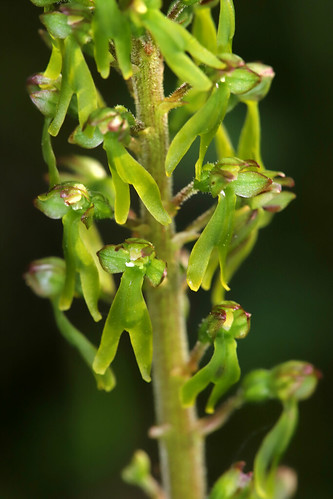 Common Twayblades began to open in the middle of April, and carried on flowering as the spikes got longer, more flowers on each spike opened, stretching their flowering season through May, June and even into July. And yet is so easy to take this green orchid for granted. They grown well in woods, on downs and in meadows. And just get on with their short lives without being showy.
Common Twayblades began to open in the middle of April, and carried on flowering as the spikes got longer, more flowers on each spike opened, stretching their flowering season through May, June and even into July. And yet is so easy to take this green orchid for granted. They grown well in woods, on downs and in meadows. And just get on with their short lives without being showy.One of the biggest change of the season for me has been the social element of it. I run a group on Facebook, and although the purpose of the group has changed, this year saw lots more active members join, and on my second visit to Marden, we bumped into members of the group, and their passion and enthusuasm really rubbed off on me, and made me think about what I do, and whether I should share my knowledge. 2018 was best remembered for the drought and its effects not just on the orchids, but on their sites too, and the numbers of people might have slightly increased, it was the fact the grasses and other plants has dried and died and did not recover until rain fell at the end of JUly. By then many of the sites, Park Gate Down especially, looked wrecked, and the people snapping the single Lady trampled on the the Musks, making the single spike that did show look very sorry indeed.
I would arrange several group meets through the season, and each one was very weel attended, and enthused me even further. Many thanks to the members of the group for making the season so memorable.
Back to the orchids.
May 3rd saw the first spike of Man Orchid on Lydden Down. The bank faces west so only gets sun in the afternoon, so the spikes are behind those in the north of the county.
 The Green Fly showed in early May, and I snapped it on the 10th, only two spikes reappeared this year, the one that got broken last year failed to show.
The Green Fly showed in early May, and I snapped it on the 10th, only two spikes reappeared this year, the one that got broken last year failed to show. And the woods and Downs began to be filled by crowds of Lady Orchids, of all shape, size, colours and density. Every one different and all needed to be photographed, but there isn't enough time.
And the woods and Downs began to be filled by crowds of Lady Orchids, of all shape, size, colours and density. Every one different and all needed to be photographed, but there isn't enough time. Once upon a time, the Late SPider would be seen at the end of May, beginning of June, so there was little chance of an overlap with the Earlies. But for the third year running, the same spike showed first, this time on 16th May, making it yet again the Early Late Spider Orchid. A better year for the species as a whole, with the population at Wye being fantastic this year.
Once upon a time, the Late SPider would be seen at the end of May, beginning of June, so there was little chance of an overlap with the Earlies. But for the third year running, the same spike showed first, this time on 16th May, making it yet again the Early Late Spider Orchid. A better year for the species as a whole, with the population at Wye being fantastic this year.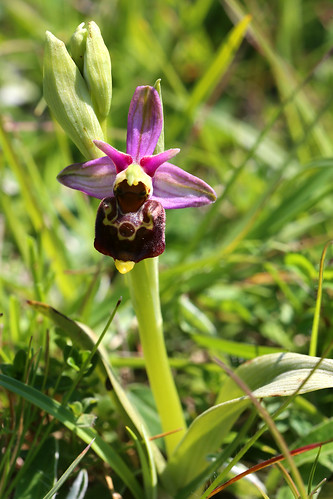 Back at Park Gate, the Monkey were in full swing by the middle of May, and numbers up again this year, and spreading towards the quarry, with these being earlier than those in the 2nd paddock.
Back at Park Gate, the Monkey were in full swing by the middle of May, and numbers up again this year, and spreading towards the quarry, with these being earlier than those in the 2nd paddock.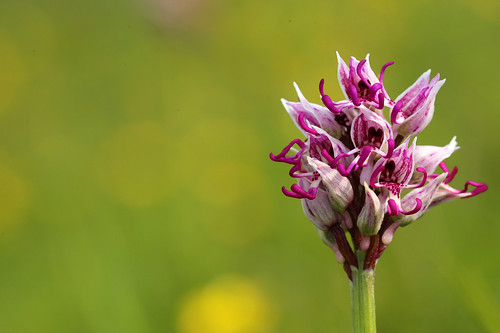 Most disappointing species really, was the Lesser Butterflies. The colony at Covet Wood failed completely. No amount of searching deep into the wood found a spike at all. In fact it was a friend who found the only spike I know of in the county, back at Steps, a single perfect spike growing beside the path in one of the lower meadows.
Most disappointing species really, was the Lesser Butterflies. The colony at Covet Wood failed completely. No amount of searching deep into the wood found a spike at all. In fact it was a friend who found the only spike I know of in the county, back at Steps, a single perfect spike growing beside the path in one of the lower meadows. On Mum's birthday, we went to the Medway Valley for the annual hunt for the Early Marsh, and we surprised to have found the whole reserve having been cut back, and the orchids showered well all over, and at the far end three pure Early Marsh were found. These seem to hybridise with the Common Spotted which are invading the site as it dries out.
On Mum's birthday, we went to the Medway Valley for the annual hunt for the Early Marsh, and we surprised to have found the whole reserve having been cut back, and the orchids showered well all over, and at the far end three pure Early Marsh were found. These seem to hybridise with the Common Spotted which are invading the site as it dries out. 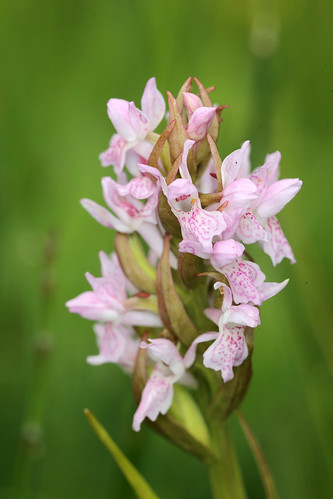 Showing that no matter how good your orchid eyes are, I found three spikes of Bee Orchid beside the sea on Thanet, a week after looking at the same site and finding no rosettes. The site is still a pale shadow of what it was before last year's drought, but it might come back.
Showing that no matter how good your orchid eyes are, I found three spikes of Bee Orchid beside the sea on Thanet, a week after looking at the same site and finding no rosettes. The site is still a pale shadow of what it was before last year's drought, but it might come back. Elsewhere on the site, Southern Marsh were showing well, huddled under clumps of bushes, just waiting to be discovered. And nearby, the Yellow Man were also showing well and spreading.
Elsewhere on the site, Southern Marsh were showing well, huddled under clumps of bushes, just waiting to be discovered. And nearby, the Yellow Man were also showing well and spreading. On the first day of my orchid vacation, May 16th, I took a member of the orchid group up onto Lydden Down to look for the Burnt Tip, and on the walk up we met with the warden who was more than happy to show us this year's plants.
On the first day of my orchid vacation, May 16th, I took a member of the orchid group up onto Lydden Down to look for the Burnt Tip, and on the walk up we met with the warden who was more than happy to show us this year's plants.Plants.
Yes, one spike last year. Two this year.
 In fact, a third was found the next day we were there, so small, it was like a clover. Hope spring anew for this species in Kent.
In fact, a third was found the next day we were there, so small, it was like a clover. Hope spring anew for this species in Kent.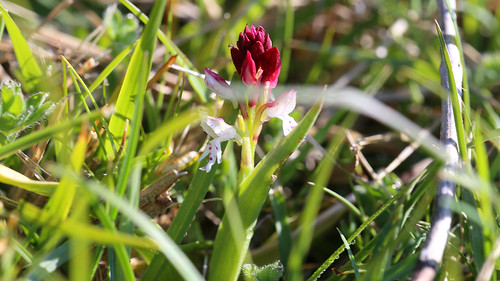 Into June now, and on the 7th I finally found the first tiny Musk spike. It took some finding, here is a shot with a 20 pence piece for scale.
Into June now, and on the 7th I finally found the first tiny Musk spike. It took some finding, here is a shot with a 20 pence piece for scale.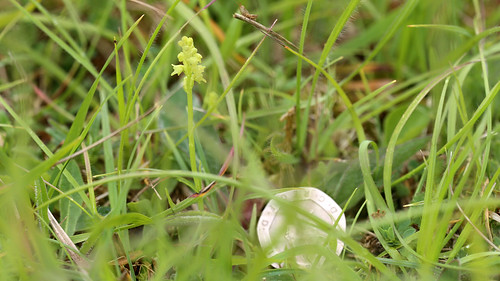 Greater Butterflies showed well through May and JUne, there being something like 25 spikes at PGD, making it the best season for them there.
Greater Butterflies showed well through May and JUne, there being something like 25 spikes at PGD, making it the best season for them there.  And again, the colony is spreading again, into the middle paddock now.
And again, the colony is spreading again, into the middle paddock now.Two days later, and on Ken's only acid bog, the Heath Spotted were showing well, though no var. alba again this year.
 As the Monkey fade at PGD, Common Spotted come out in force, with a good variation in shape and size, including this nice triple group.
As the Monkey fade at PGD, Common Spotted come out in force, with a good variation in shape and size, including this nice triple group.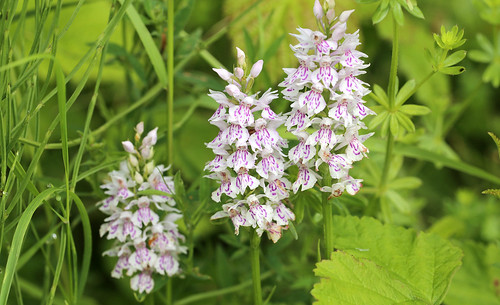 I bite the bullet and stump up the seven quid to get onto Sandwich Bay estate, and there the Lizards were in full flower, hundreds of large crazy spikes showing in the dunes, gardens and golf links, all smelling like goat's wee. I took a group here, and they were thrilled by the first one they found on a fairway.
I bite the bullet and stump up the seven quid to get onto Sandwich Bay estate, and there the Lizards were in full flower, hundreds of large crazy spikes showing in the dunes, gardens and golf links, all smelling like goat's wee. I took a group here, and they were thrilled by the first one they found on a fairway.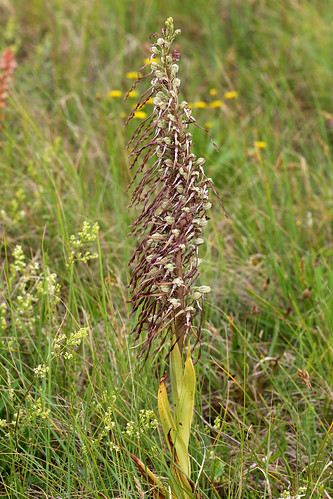 A good year too for the Pyramidal which were in huge numbers too at Sandwich Bay, but also along the cliffs and beside most of the main roads in East Kent too, Tjough no var. albas seen again, though some pale pink ones were seen.
A good year too for the Pyramidal which were in huge numbers too at Sandwich Bay, but also along the cliffs and beside most of the main roads in East Kent too, Tjough no var. albas seen again, though some pale pink ones were seen.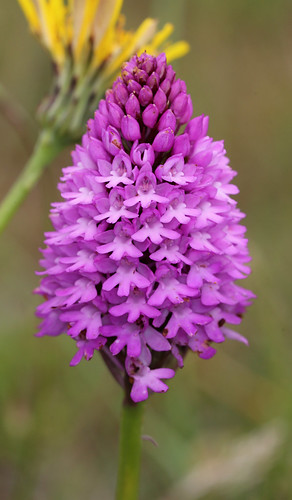 I had been told by several people that the tops of Lydden and Temple Ewell Dons can be coloured purple by the sheer numbers of Common (Chalk) Fragrants, but finding time to get up there was always difficult. But at the end of June, I finally got to see a pinky-purple carpet, as far as the eye could see. If you lay down.
I had been told by several people that the tops of Lydden and Temple Ewell Dons can be coloured purple by the sheer numbers of Common (Chalk) Fragrants, but finding time to get up there was always difficult. But at the end of June, I finally got to see a pinky-purple carpet, as far as the eye could see. If you lay down. They were past their peak, but still glorious.
They were past their peak, but still glorious.At the very end of June, the Marsh Helleborines were at their peak, and we paid them a visit. The site is too fragile to have a huge group going there, so I told members to go themselves, so they could take in the glory of the couple of hundred spikes at the only known public location in the county. Not sure if they grow anywhere else than on this reserve. There isn't much variation in colour or size, but they gather in a small community when the dune slacks around look perfectly habitable for them, but they are happy where the currently grow.
 I went to visit the Green Flowered Hellebornines twice in July, and again I never saw one flower open, but this sub-species hardly ever opens, so the tiny scrawny plants are hardly worth the trip up, unless you were passing going somewhere else more interesting. I met a photographer here, who was looking for the fields of lavender. He saw me get my camera, macro lens and ring flash, and looked on in wonder as I stooped to snap what looked like weeds?
I went to visit the Green Flowered Hellebornines twice in July, and again I never saw one flower open, but this sub-species hardly ever opens, so the tiny scrawny plants are hardly worth the trip up, unless you were passing going somewhere else more interesting. I met a photographer here, who was looking for the fields of lavender. He saw me get my camera, macro lens and ring flash, and looked on in wonder as I stooped to snap what looked like weeds?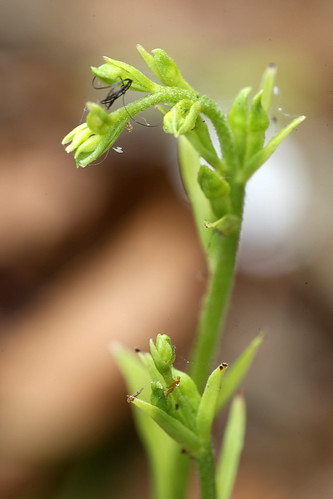 So I explained about these pathetic plants, and was happy enough to snap them too, happy having seen a rare plant.
So I explained about these pathetic plants, and was happy enough to snap them too, happy having seen a rare plant.And so we enter the final weeks of the season, and I take a large group of members of the FB orchid group to The Larches to look on in wonder at the Broad Leaved Helleborines.
 There was a good show, including a var flavecens, which I found! Me, me, me.
There was a good show, including a var flavecens, which I found! Me, me, me.Though to see the densely flowering spikes form a distance is still another fine sight in Kent.
 I took another group into the woods at Barham to find the Violets, they were very, very late, and I went week after week to make sure that when the group came, there would be something to see.
I took another group into the woods at Barham to find the Violets, they were very, very late, and I went week after week to make sure that when the group came, there would be something to see.Thankfully the members not only enjoyed the spikes I found, but found many of their own nearby.
Which was nice.
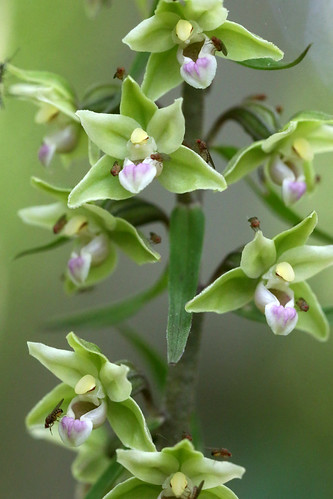 And finally, the ALTs.
And finally, the ALTs.I failed to get the council from mowing around the monument this year. They did show in the end, but in reduced numbers.
 Whilst up on Lydden Down, looking for Silver Spotted Skippers, I found dozens of spikes there, which was a pleasant surprise.
Whilst up on Lydden Down, looking for Silver Spotted Skippers, I found dozens of spikes there, which was a pleasant surprise. But then there is the house along the coast, with its thousands and thousands of spikes, now spreading onto the grassed area out front. More than enough spikes there for everyone.
But then there is the house along the coast, with its thousands and thousands of spikes, now spreading onto the grassed area out front. More than enough spikes there for everyone.So, nothing rare and/or exciting this season, but the excitement is building for the new one, just three months or so, away. Who know what we will find, maybe a Sword Leaved Helleborine or a Frog when they are reintroduced.
How exciting will that be?

No comments:
Post a Comment